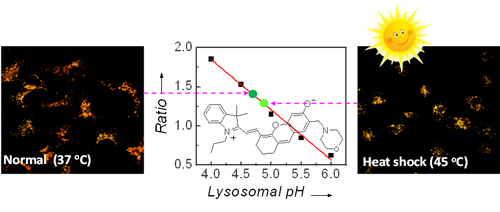New spectroscopic (chromogenic, fluorescent, or chemiluminescent) probes have attracted significant attention because they are the basis for the construction of various spectroscopic sensing and imaging approaches. Prof. Huimin Ma’s group from the CAS Key Laboratory of Analytical Chemistry for Living Biosystems has been engaged in this field for more than two decades, during which a series of new spectroscopic probes and sensing/labeling methods for biologically active species have been developed by employing different chemical reactions. Due to their superior accomplishments in the field, Prof. Ma and his colleagues have been invited to contribute a few review articles (Chem. Commun., 2012, 48, 8732-8744; Chem. Rev., 2014, 114, 590-659).
Recently, by choosing nitroaromatic compounds as recognition moieties, this research group has proposed several spectroscopic off-on probes with analytical long wavelength for nitroreductase assay, and the probes have been used for visualizing the distribution of nitroreductase in living zebrafish, which shows that zebrafish yolk sac may be the major occurrence site of nitroreductase (Chem. Asian J., 2014, 9, 2058; Biosens. Bioelectron., 2015, 63, 112). More notably, by designing a lysosome-targeting fluorescent pH probe, they revealed the relationship between the lysosomal pH value and temperature during heat shock. As is known, heat stroke is a life-threatening condition, featuring with a high body temperature and malfunction of many organ systems. However, the relationship between heat shock and lysosomes is poorly understood, mainly because of the lack of a suitable research approach. To solve this issue, by incorporating morpholine into a stable hemicyanine skeleton, Prof. Ma and his colleagues developed Lyso-pH as a new lysosome-targeting near-infrared ratiometric pH probe, and in combination with fluorescence imaging they found that the lysosomal pH is increased but never decreased during heat shock (Figure 1), which may result from lysosomal membrane permeabilization. They also demonstrated that such a lysosomal pH rise is irreversible in live cells. Moreover, Lyso-pH is easy to synthesize, and shows superior overall analytical performance as compared to the existing commercial ones, which may enable it to be widely used in more lysosomal models of live cells and in further understanding the mechanisms underlying heat-related pathology (Angew. Chem. Int. Ed., 2014, 53, 10916-10920).

Figure 1. Lysosomal pH irreversible rise during heat shock monitored by new fluorescent pH probe.
